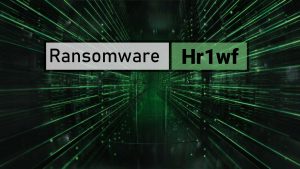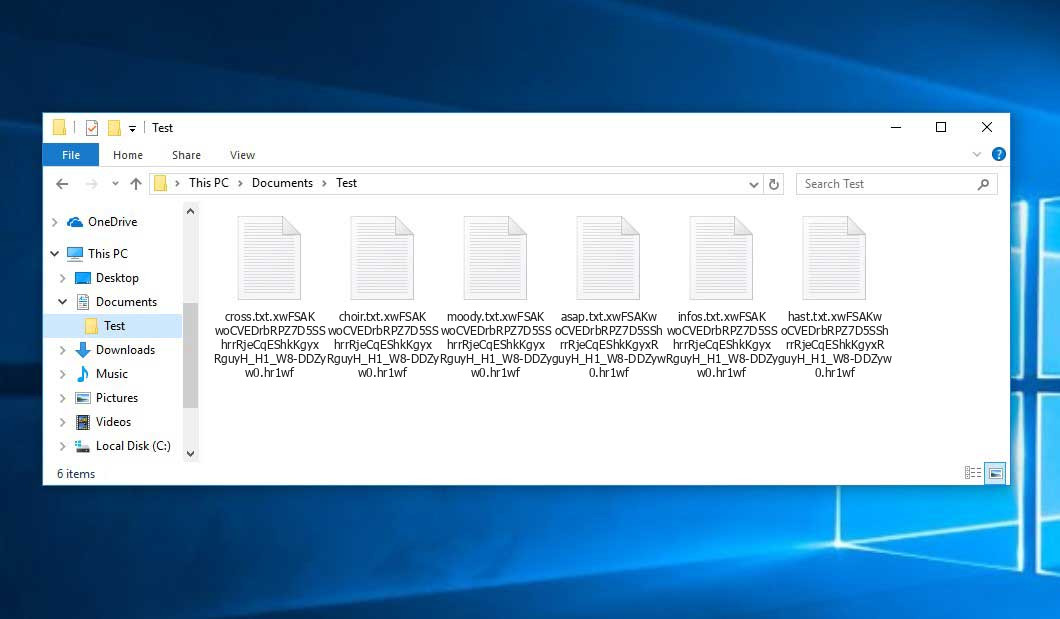The Hr1wf virus belongs under the ransomware type of infection. Malware of this type encrypts all the data on your PC (images, documents, excel sheets, music, videos, etc) and adds its own extension to every file, leaving the i1jv_HOW_TO_DECRYPT.txt text files in each folder with the encrypted files.
What is known about the Hr1wfvirus?
☝️ A strictly correct description for the Hr1wf is “a ransomware infection”.
The renaming will be done by this pattern: **random_symbols**.hr1wf. In the course of encryption, a file named, for example, “report.docx” will be changed to “report.docx.xwFSAKwoCVEDrbRPZ7D5SShrrRjeCqEShkKgyxRguyH_H1_W8-DDZyw0.hr1wf”.
In every folder with the encoded files, a i1jv_HOW_TO_DECRYPT.txt file will be found. It is a ransom money memo. It contains information on the ways of contacting the racketeers and some other information. The ransom note most probably contains a description of how to buy the decryption tool from the Hr1wf developers. That is how they do it.
Hr1wf summary:
| Name | Hr1wf Virus |
| Extension | .**random_symbols**.hr1wf |
| Ransomware note | i1jv_HOW_TO_DECRYPT.txt |
| Detection | Trojan:Win32/Bandit.DSK!MTB, Trojan-Ransom.Win32.Encoder.aeh, Trojan.Win32.Miner.tkva |
| Symptoms | Your files (photos, videos, documents) get a .**random_symbols**.hr1wf extension and you can’t open them. |
| Fix Tool | See If Your System Has Been Affected by Hr1wf virus |
In the screenshot below, you can see what a directory with files encrypted by the Hr1wf looks like. Each filename has the “.**random_symbols**.hr1wf” extension appended to it.
How did my computer get infected with Hr1wf ransomware?
There is a huge number of possible ways of ransomware injection.
There are currently three most exploited methods for malefactors to have ransomware acting in your digital environment. These are email spam, Trojan infiltration and peer-to-peer file transfer.
If you open your inbox and see letters that look just like notifications from utility services companies, postal agencies like FedEx, Internet providers, and whatnot, but whose addresser is strange to you, beware of opening those emails. They are very likely to have a harmful file attached to them. Thus it is even more dangerous to download any attachments that come with emails like these.
Another thing the hackers might try is a Trojan virus scheme1. A Trojan is an object that gets into your PC pretending to be something different. Imagine, you download an installer of some program you want or an update for some program. But what is unpacked turns out to be a harmful agent that corrupts your data. Since the update file can have any name and any icon, you have to make sure that you can trust the resource of the stuff you’re downloading. The best way is to trust the software developers’ official websites.
As for the peer-to-peer file transfer protocols like BitTorrent or eMule, the danger is that they are even more trust-based than the rest of the Internet. You can never guess what you download until you get it. So you’d better be using trustworthy resources. Also, it is reasonable to scan the directory containing the downloaded objects with the antivirus as soon as the downloading is done.
How do I get rid of the Hr1wf virus?
It is important to inform you that besides encrypting your data, the Hr1wf virus will most likely deploy the Azorult Spyware on your PC to seize your credentials to different accounts (including cryptocurrency wallets). The mentioned program can derive your logins and passwords from your browser’s auto-filling cardfile.
Sometimes racketeers would unblock some of your files to prove that they really have the decryption tool. As Hr1wf virus is a relatively recent ransomware, safety measures engineers have not yet found a method to undo its work. However, the decoding tools are frequently updated, so the solution may soon be available.
Sure thing, if the hackers do the job of encrypting someone’s essential files, the hopeless person will probably comply with their demands. However, paying a ransom does not necessarily mean that you’re getting your files back. It is still dangerous. After getting the ransom, the racketeers may send a wrong decryption key to the victim. There were reports about ransomware developers just vanishing after getting the ransom without even writing back.
The optimal countermeasure to ransomware is to have a system restore point or the copies of your critical files in the cloud drive or at least on an external drive. Obviously, that might be not enough. The most important thing could be that one you were working on when it all started. But at least it is something. It is also wise to scan your drives with the anti-malware utility after the system restoration.
Hr1wf is not the only ransomware of its kind, since there are other specimens of ransomware out there that act in the same manner. For instance, Wuxia, Xqxqx, Phv1, and some others. The two major differences between them and the Hr1wf are the ransom amount and the method of encryption. The rest is almost identical: documents become encoded, their extensions changed, ransom notes appear in each directory containing encoded files.
Some fortunate users were able to decrypt the blocked files with the help of the free software provided by anti-malware specialists. Sometimes the hackers mistakenly send the decryption code to the wronged in the ransom readme. Such an extraordinary fail allows the injured part to restore the files. But obviously, one should never rely on such a chance. Remember, ransomware is a tamperers’ tool to lay their hands on the money of their victims.
How сan I avoid ransomware attack?
Hr1wf ransomware has no endless power, so as any similar malware.
You can defend your computer from its attack in three easy steps:
- Ignore any emails from unknown senders with unknown addresses, or with content that has nothing to do with something you are waiting for (can you win in a money prize draw without participating in it?). If the email subject is more or less something you are waiting for, check all elements of the dubious email carefully. A hoax email will always have mistakes.
- Never use cracked or untrusted programs. Trojan viruses are often distributed as a part of cracked products, most likely as a “patch” which prevents the license check. But potentially dangerous programs are very hard to tell from trustworthy software, because trojans sometimes have the functionality you seek. Try to find information on this software product on the anti-malware forums, but the best way is not to use such software.
- And finally, to be sure about the safety of the files you downloaded, scan them with GridinSoft Anti-Malware. This program will be a powerful armor for your PC.
Reasons why I would recommend GridinSoft2
There is no better way to recognize, remove and prevent ransomware than to use an anti-malware software from GridinSoft3.
Download Removal Tool.
You can download GridinSoft Anti-Malware by clicking the button below:
Run the setup file.
When setup file has finished downloading, double-click on the setup-antimalware-fix.exe file to install GridinSoft Anti-Malware on your PC.

An User Account Control asking you about to allow GridinSoft Anti-Malware to make changes to your device. So, you should click “Yes” to continue with the installation.

Press “Install” button.

Once installed, Anti-Malware will automatically run.

Wait for the Anti-Malware scan to complete.
GridinSoft Anti-Malware will automatically start scanning your PC for Hr1wf infections and other malicious programs. This process can take a 20-30 minutes, so I suggest you periodically check on the status of the scan process.

Click on “Clean Now”.
When the scan has finished, you will see the list of infections that GridinSoft Anti-Malware has detected. To remove them click on the “Clean Now” button in right corner.

Frequently Asked Questions
🤔 Are the “.**random_symbols**.hr1wf” files accessible?
Negative. That is why ransomware is so frustrating. Until you decode the “.**random_symbols**.hr1wf” files you will not be able to access them.
🤔 The encrypted files are very important to me. How can I decrypt them quickly?
It’s good if you have fаr-sightedly saved copies of these important files elsewhere. Otherwise, you might try to employ System Restore. The only question is whether you have saved any Restore Points that would be helpful now. All other solutions require time.
🤔 Will GridinSoft Anti-Malware remove all the encrypted files alongside the Hr1wf virus?
No way! Your encrypted files are no threat to your PC.
GridinSoft Anti-Malware will delete active infections from your PC. The virus that has infected your device is probably still functional and launching checks periodically to encode any new files you might create on your PC after the initial attack. As it has been mentioned above, the Hr1wf malware comes with the company. It installs backdoors and keyloggers that can steal your account credentials and provide malefactors with easy access to your computer after some time.
🤔 What should I do if the Hr1wf ransomware has blocked my PC and I can’t get the activation key.
In such a case, you need to have a memory stick with a previously installed Trojan Killer. Use Safe Mode to execute the procedure. The point is that the ransomware starts automatically as the system launches and encodes any new files created or imported into your PC. To suppress this function – use Safe Mode, which allows only the vital programs to run upon system boot. Consider reading our manual on running Windows in Safe Mode.
🤔 What can I do right now?
Many of the blocked files might still be at your disposal
- If you exchanged your important files through email, you could still download them from your online mailbox.
- You may have shared photographs or videos with your friends or relatives. Simply ask them to give those images back to you.
- If you have initially got any of your files from the Internet, you can try downloading them again.
- Your messengers, social media pages, and cloud drives might have all those files as well.
- It might be that you still have the needed files on your old PC, a portable device, phone, flash memory, etc.
HINT: You can use data recovery utilities4 to retrieve your lost information since ransomware encodes the copies of your files, removing the original ones. In the tutorial below, you can see how to use PhotoRec for such a restoration, but be advised: you can do it only after you eradicate the virus with an anti-malware program.
Also, you can contact the following official fraud and scam sites to report this attack:
- In the United States: On Guard Online;
- In Canada: Canadian Anti-Fraud Centre;
- In the United Kingdom: Action Fraud;
- In Australia: SCAMwatch;
- In New Zealand: Consumer Affairs Scams;
- In France: Agence nationale de la sécurité des systèmes d’information;
- In Germany: Bundesamt für Sicherheit in der Informationstechnik;
- In Ireland: An Garda Síochána;
To report the attack, you can contact local executive boards. For instance, if you live in USA, you can have a talk with FBI Local field office, IC3 or Secret Service.
I need your help to share this article.
It is your turn to help other people. I have written this guide to help users like you. You can use the buttons below to share this on your favorite social media Facebook, Twitter, or Reddit.
Brendan SmithHow to Remove HR1WF Ransomware & Recover PC

Name: HR1WF Virus
Description: HR1WF Virus is a ransomware-type infections. This virus encrypts important personal files (video, photos, documents). The encrypted files can be tracked by a specific .**random_symbols**.hr1wf extension. So, you can't use them at all.
Operating System: Windows
Application Category: Virus
User Review
( votes)References
- You can read more on Trojans, their use and types in the Trojan-dedicated section of GridinSoft official website.
- GridinSoft Anti-Malware Review from HowToFix site: https://howtofix.guide/gridinsoft-anti-malware/
- More information about GridinSoft products: https://gridinsoft.com/comparison
- Here are Best Data Recovery Software Of 2023.



